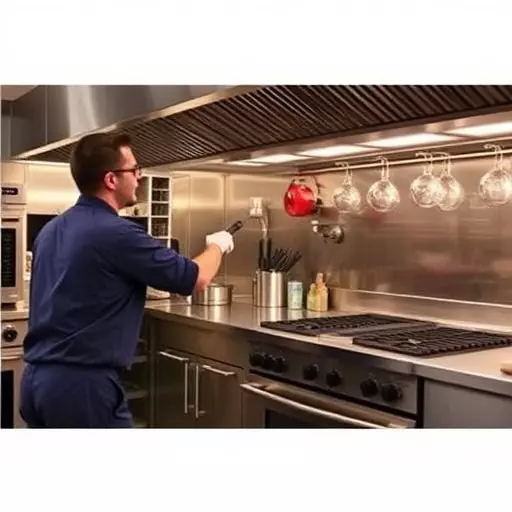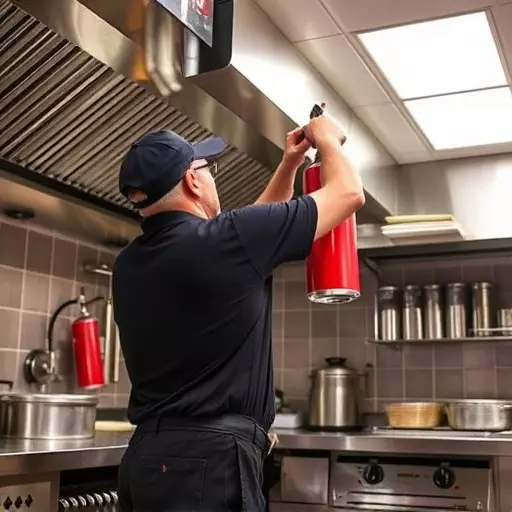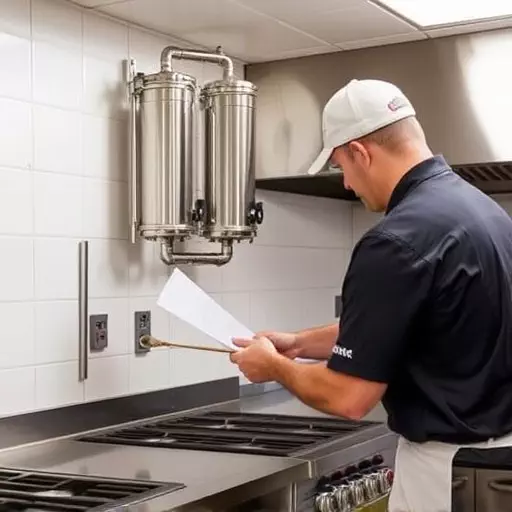Regular Kitchen Suppression Inspections in Spring Lake are vital for ensuring optimal fire safety and compliance. These thorough assessments cover all critical components of kitchen fire suppression systems, from sprinkler heads to alarms and detection systems. By identifying and rectifying potential issues, these inspections minimize hazards, enhance response times, and maintain uninterrupted kitchen operations. Certified professionals test and calibrate equipment, maintain records, and conduct drills, fostering a culture of safety awareness in commercial kitchens where fire risk is high. Compliance checks guarantee swift and effective responses during emergencies while keeping staff well-trained on evacuation routes.
“In the dynamic landscape of commercial kitchens, emergency preparedness is not a luxury but an absolute necessity. This comprehensive guide explores the vital aspects of kitchen suppression inspections in Spring Lake, focusing on fire safety. From understanding specialized fire suppression systems to identifying potential hazards and implementing best practices, this article equips professionals with actionable insights. Learn how regular maintenance checks, thorough evaluations, and proactive compliance ensure your kitchen is ready to face any fire-related emergency.”
- Understanding Kitchen Fire Suppression Systems
- The Importance of Regular Inspection and Maintenance
- Key Components to Evaluate During a Kitchen Suppression Inspection
- Identifying Potential Hazards and Compliance Issues
- Best Practices for Ensuring Fire Safety in Commercial Kitchens
- Post-Inspection: Actionable Steps for Enhanced Kitchen Fire Preparedness
Understanding Kitchen Fire Suppression Systems

Staying safe in the kitchen starts with understanding fire suppression systems designed to combat blazes that may erupt while cooking or cleaning. In Spring Lake, regular Kitchen Suppression Inspection is a vital part of ensuring Fire suppression compliance checks are up-to-date and functioning optimally. These inspections go beyond merely checking for the presence of extinguishers; they involve thorough assessments of the entire kitchen fire suppression system. This includes examining sprinkler heads, pipes, and valves for any signs of damage, corrosion, or blockages that could hinder their effectiveness in an emergency.
During these inspections, professionals also verify the proper operation of alarms and detection systems, ensuring they alert occupants promptly in case of a fire. They check battery life in smoke detectors and test the connectivity between control panels to ensure seamless coordination during fire suppression efforts. Regular kitchen suppression system inspections are not just about meeting regulatory requirements; they’re about safeguarding lives, protecting property, and promoting peace of mind for every resident or worker in the kitchen.
The Importance of Regular Inspection and Maintenance

Regular inspections and maintenance are vital components of any comprehensive emergency preparedness plan for kitchens in Spring Lake. Kitchen suppression systems, designed to contain and suppress fires quickly, require routine checks to ensure optimal functionality. These inspections go beyond simple visual assessments; they involve testing and calibrating each component to meet fire suppression compliance standards. By maintaining these systems, kitchen staff can minimize potential hazards and maximize response time during an emergency.
A well-maintained kitchen suppression system is a key line of defense against the devastating effects of fires in commercial kitchens. Regular inspections help identify any issues or wear and tear, allowing for prompt repairs or replacements. This proactive approach not only keeps the kitchen safe but also ensures uninterrupted operations, as downtime due to non-compliant fire systems can be costly and disruptive.
Key Components to Evaluate During a Kitchen Suppression Inspection

During a Kitchen Suppression Inspection in Spring Lake, several key components need careful evaluation to ensure fire suppression compliance. First and foremost, inspect the presence and functionality of a kitchen suppression system, which includes detecting devices like heat or smoke alarms and automated sprinkler heads. These systems are vital for swiftly identifying and containing fires within their origin, minimizing damage and protecting lives.
Additionally, assess the proper storage and accessibility of fire extinguishers, especially those designed for kitchen use, such as Class K extinguishers. Verifying regular maintenance records and ensuring clear signage indicating emergency equipment locations is crucial. Evaluating evacuation plans and practicing drills can also enhance the overall preparedness of kitchen staff in the event of a fire.
Identifying Potential Hazards and Compliance Issues

Identifying potential hazards and ensuring fire suppression compliance is a critical step in emergency preparedness for kitchens. A thorough Kitchen Suppression Inspection Spring Lake should evaluate various risks, such as the presence of flammable materials, proper ventilation systems, and the functionality of kitchen suppression systems. Regular checks by certified professionals are essential to verify that these systems meet Fire Suppression Compliance standards.
Compliance issues may include outdated equipment, incorrect installation, or lack of regular maintenance, all of which can pose significant risks during a fire emergency. By addressing these issues proactively, kitchen staff can significantly enhance safety measures and ensure a more effective response in the event of a fire.
Best Practices for Ensuring Fire Safety in Commercial Kitchens

In commercial kitchens, fire safety is paramount due to the high risk of rapid fire spread and intense heat generation. Best practices involve regular Kitchen Suppression System Inspection in Spring Lake to ensure that fire suppression equipment is functioning correctly and readily available. This includes thorough testing of sprinkler systems, fire alarms, and extinguisher devices, along with comprehensive documentation of all maintenance activities.
Regular compliance checks, such as Fire Suppression Compliance Checks, are essential to maintain the integrity of safety protocols. Kitchens should implement rigorous training programs for staff on fire safety procedures, evacuation routes, and the proper use of suppression equipment. Additionally, keeping cooking areas clean and free from combustible materials significantly reduces fire hazards. Regular Kitchen Suppression Inspections in Spring Lake not only ensure Fire Suppression Compliance but also foster a culture of safety awareness among kitchen personnel.
Post-Inspection: Actionable Steps for Enhanced Kitchen Fire Preparedness

After a thorough Kitchen Suppression Inspection in Spring Lake, it’s crucial to translate the findings into actionable steps for enhanced fire preparedness. The first step is to assess the current fire suppression system and ensure it complies with all necessary regulations. This involves verifying the proper functioning of kitchen-specific systems like grease traps and suppressors, as well as regular maintenance records.
Next, address any gaps or deficiencies identified during the inspection. Install additional fire suppression equipment where needed, update outdated systems, and provide comprehensive staff training on emergency procedures specific to kitchen fires. Regularly schedule compliance checks to maintain fire suppression certification, ensuring a swift and effective response in case of a fire outbreak.


